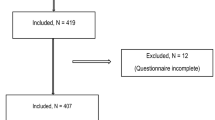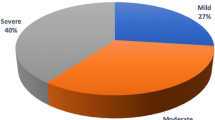Abstract
Purpose
A prospective observational study is conducted to identify independent predictors of pain and morphine consumption following abdominal hysterectomy.
Methods
Preoperative State Trait Anxiety Inventory (STAI), Numerical Rating Scales (NRS) for anxiety and pain expectations, thermal pain thresholds and pain scores at forearm and incision site, and pain scores generated from the insertion of an intravenous catheter were measured in female patients undergoing abdominal hysterectomy. Pearson correlations between the predictors and the two outcome measures postoperative pain scores and morphine consumption were studied and multiple regression analysis was conducted to identify independent predictors (primary outcome). Secondary outcomes included cut-off values of predictive tools for morphine consumption.
Results
Data from 60 patients were analyzed. STAI state anxiety, NRS pain expectations, and NRS anxiety scores were identified as independent predictors of postoperative morphine consumption. We identified a cut-off value of 4.5 (sensitivity 90 %, specificity of 60 %) for the NRS anxiety and a cut-off of 42.5 (sensitivity 70 %, specificity 70 %) for the state anxiety STAI score for increased postoperative morphine consumption.
Conclusions
Preoperative STAI state anxiety scores and NRS pain expectations are independent predictors for increased morphine consumption following hysterectomy. The STAI state anxiety tool and NRS 0-10 anxiety tool can be used interchangeably. The NRS 0-10 anxiety is a much simpler tool than STAI state anxiety and is associated with a higher sensitivity for high morphine consumption. Thermal pain thresholds and IV pain scores were not predictive of postoperative morphine consumption.
Similar content being viewed by others
References
Gramke HF, de Rijke JM, van Kleef M, Raps F, Kessels AG, Peters ML, Sommer M, Marcus MA. The prevalence of postoperative pain in a cross-sectional group of patients after day-case surgery in a university hospital. Clin J Pain. 2007;23:543–8.
Fletcher D, Fermanian C, Mardaye A, Aegerter P. A patient-based national survey on postoperative pain management in France reveals significant achievements and persistent challenges. Pain. 2008;137:441–51.
Benhamou D, Berti M, Brodner G, De Andres J, Draisci G, Moreno-Azcoita M, Neugebauer EA, Schwenk W, Torres LM, Viel E. Postoperative analgesic THerapy observational survey (PATHOS): a practice pattern study in 7 central/southern European countries. Pain. 2008;136:134–41.
Sommer M, de Rijke JM, van Kleef M, Kessels AG, Peters ML, Geurts JW, Gramke HF, Marcus MA. The prevalence of postoperative pain in a sample of 1490 surgical inpatients. Eur J Anaesthesiol. 2008;25:267–74.
Perkins FM, Kehlet H. Chronic pain as an outcome of surgery. A review of predictive factors. Anesthesiology. 2000;93:1123–33.
Stamer UM, Stuber F. The pharmacogenetics of analgesia. Expert Opin Pharmacother. 2007;8:2235–45.
Ip HY, Abrishami A, Peng PW, Wong J, Chung F. Predictors of postoperative pain and analgesic consumption: a qualitative systematic review. Anesthesiology. 2009;111:657–77.
Werner MU, Mjobo HN, Nielsen PR, Rudin A. Prediction of postoperative pain: a systematic review of predictive experimental pain studies. Anesthesiology. 2010;112:1494–502.
Pan PH, Coghill R, Houle TT, Seid MH, Lindel WM, Parker RL, Washburn SA, Harris L, Eisenach JC. Multifactorial preoperative predictors for postcesarean section pain and analgesic requirement. Anesthesiology. 2006;104:417–25.
Soysal S, Topacoglu H, Karcioglu O, Serinken M, Koyuncu N, Sarikaya S. Analysis of factors affecting pain in intravenous catheter placement: a survey of 925 patients. Int J Clin Pract. 2005;59:675–9.
Wylde V, Palmer S, Learmonth ID, Dieppe P. Somatosensory abnormalities in knee OA. Rheumatology (Oxford). 2012;51:535–43.
Palmer ST, Martin DJ, Steedman WM, Ravey J. C- and Adelta-fibre mediated thermal perception: response to rate of temperature change using method of limits. Somatosens Mot Res. 2000;17:325–33.
Pinto PR, McIntyre T, Fonseca C, Almeida A, Araújo-Soares V. Pre- and post-surgical factors that predict the provision of rescue analgesia following hysterectomy. Eur J Pain. 2013;17:423–33.
Pinto PR, McIntyre T, Nogueira-Silva C, Almeida A, Araújo-Soares V. Risk factors for persistent postsurgical pain in women undergoing hysterectomy due to benign causes: a prospective predictive study. J Pain. 2012;13:1045–57.
Janssen KJ, Kalkman CJ, Grobbee DE, Bonsel GJ, Moons KG, Vergouwe Y. The risk of severe postoperative pain: modification and validation of a clinical prediction rule. Anesth Analg. 2008;107:1330–9.
Page DE, Taylor DM. Vapocoolant spray vs. subcutaneous lidocaine injection for reducing the pain of intravenous cannulation: a randomized, controlled, clinical trial. Br J Anaesth. 2010;105:519–25.
Robinson PA, Carr S, Pearson S, Frampton C. Lignocaine is a better analgesic than either ethyl chloride or nitrous oxide for peripheral intravenous cannulation. Emerg Med Australas. 2007;19:427–32.
Macario A, Weinger M, Truong P, Lee M. Which clinical anesthesia outcomes are both common and important to avoid? The perspective of a panel of expert anesthesiologists. Anesth Analg. 1999;88:1085–91.
Granot M, Lowenstein L, Yarnitsky D, Tamir A, Zimmer EZ. Postcesarean section pain prediction by preoperative experimental pain assessment. Anesthesiology. 2003;98:1422–6.
Kain ZN, Sevarino F, Alexander GM, Pincus S, Mayes LC. Preoperative anxiety and postoperative pain in women undergoing hysterectomy. A repeated-measures design. J Psychosom Res. 2000;49:417–22.
Carvalho B, Zheng M, Aiono-Le Tagaloa L. A prospective observational study evaluating the ability of prelabor psychological tests to predict labor pain, epidural analgesic consumption, and maternal satisfaction. Anesth Analg. 2014;119:632–40.
Acknowledgments
The authors would like to thank Dr Muhieddine Seoud as the primary surgeon in this study and for facilitating the recruitment of cases.
Conflict of interest
The author(s) declare that they have no competing interests.
Author information
Authors and Affiliations
Corresponding author
About this article
Cite this article
Aouad, M.T., Kanazi, G.E., Malek, K. et al. Predictors of postoperative pain and analgesic requirements following abdominal hysterectomy: an observational study. J Anesth 30, 72–79 (2016). https://doi.org/10.1007/s00540-015-2090-0
Received:
Accepted:
Published:
Issue Date:
DOI: https://doi.org/10.1007/s00540-015-2090-0




